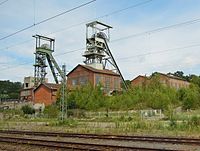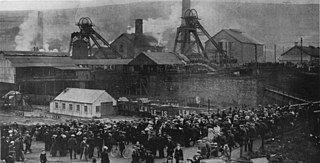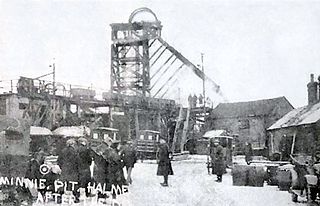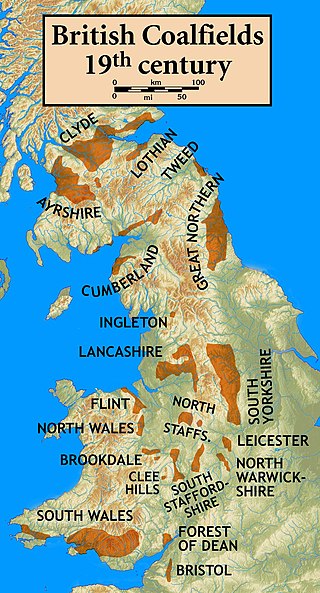
The Luisenthal mine disaster was the most serious mine accident in the history of the Federal Republic of Germany. The explosion killed 299 miners. [1]

The Luisenthal mine disaster was the most serious mine accident in the history of the Federal Republic of Germany. The explosion killed 299 miners. [1]
The Luisenthal Mine is located in Völklingen, a town in the state of Saarland, Germany. The mine has been in operation since the 1800s, although coal has been mined in Luisthenal since 1719. [2] The Luisenthal mine was considered to be very susceptible to firedamp explosions due to the high concentration of firedamp in the seams. From 1904 to 1954 there were 20 fires and explosions in the pit. In 1941, an explosion killed 41 miners. Because of this, the pit was equipped with state-of-the-art technology. Subsequently, the mine was awarded for its high safety standards. [3]
During the early shift on 7 February 1962, there were 664 miners working in the pit. Around 7:45 a.m., an explosion occurred in the Alsbach shaft of the mine at a depth of more than 600 meters, (more than 1,968 feet). [4] The explosion was strong enough to lift the manhole cover off the Alsbach shaft. [5] 299 miners were killed in the explosion, while 73 miners were injured. Some of those who died underground were burned beyond recognition.
The cause of the explosion is still unclear. Among other things, it was speculated whether a miner had smoked illegally underground, because cigarettes were found during the clean-up work. A defective mine lamp was also named as a possible cause. Today, it is believed that a coal dust explosion occurred as a result of a primary firedamp explosion. [6]

On 11 February 1962, a memorial was held for 286 of the dead miners. The memorial was led by the then West Germany President, Heinrich Luebke. Around 4,500 people were in attendance. [7]
The Luisenthal Mine closed down on 17 June 2005. Near the now abandoned pit there is a memorial with a statue of St. Barbara, the patron saint of miners. [8] A wall of 299 stones with continuous niches for placing memorial candles symbolizes the 299 victims of the accident. The monument was made by the artist Lothar Meßner (1926–2019). [9] There is also a memorial to the dead miners in the building of the Saarbrücken Mining Directorate. The memorial is a series of three stained glass windows, and is titled "Our Dead Miners". [10]

The Davy lamp is a safety lamp used in flammable atmospheres, invented in 1815 by Sir Humphry Davy. It consists of a wick lamp with the flame enclosed inside a mesh screen. It was created for use in coal mines, to reduce the danger of explosions due to the presence of methane and other flammable gases, called firedamp or minedamp.
Coal dust is a fine-powdered form of coal which is created by the crushing, grinding, or pulverization of coal rock. Because of the brittle nature of coal, coal dust can be created by mining, transporting, or mechanically handling it.
Firedamp is any flammable gas found in coal mines, typically coalbed methane. It is particularly found in areas where the coal is bituminous. The gas accumulates in pockets in the coal and adjacent strata and when they are penetrated the release can trigger explosions. Historically, if such a pocket was highly pressurized, it was termed a "bag of foulness".
The Blantyre mining disaster, which happened on the morning of 22 October 1877, in Blantyre, Scotland, was Scotland's worst ever mining accident. Pits No. 2 and No. 3 of William Dixon's Blantyre Colliery were the site of an explosion which killed 207 miners, possibly more, with the youngest being a boy of 11. It was known that firedamp was present in the pit and it is likely that this was ignited by a naked flame. The accident left 92 widows and 250 fatherless children.
Afterdamp is the toxic mixture of gases left in a mine following an explosion caused by methane-rich firedamp, which itself can initiate a much larger explosion of coal dust. The term is etymologically and practically related to other terms for underground mine gases—such as firedamp, white damp, and black damp, with afterdamp being composed, rather, primarily by carbon dioxide, carbon monoxide and nitrogen, with highly toxic stinkdamp-constituent hydrogen sulfide possibly also present. However, the high content of carbon monoxide is the component that kills, preferentially combining with haemoglobin in the blood and thus depriving victims of oxygen. Globally, afterdamp has caused many of the casualties in disasters of pit coalfields, including British, such as the Senghenydd colliery disaster. Such disasters continue to afflict working mines, for instance in mainland China.

Easington Colliery is a village in County Durham, England, known for a history of coal mining. It is situated to the north of Horden, a short distance to the east of Easington. It had a population of 4,959 in 2001, and 5,022 at the 2011 Census.

The Luisenthal Mine was a coal mine near Völklingen. The mine was known as the site of the largest mine accident in the history of the German Federal Republic, when 299 miners died on 7 February 1962.
A safety lamp is any of several types of lamp that provides illumination in places such as coal mines where the air may carry coal dust or a build-up of inflammable gases, which may explode if ignited, possibly by an electric spark. Until the development of effective electric lamps in the early 1900s, miners used flame lamps to provide illumination. Open flame lamps could ignite flammable gases which collected in mines, causing explosions; safety lamps were developed to enclose the flame to prevent it from igniting the explosive gases. Flame safety lamps have been replaced for lighting in mining with sealed explosion-proof electric lights, but continue to be used to detect gases.

The Senghenydd colliery disaster, also known as the Senghenydd explosion, occurred at the Universal Colliery in Senghenydd, near Caerphilly, Glamorgan, Wales, on 14 October 1913. The explosion, which killed 439 miners and a rescuer, is the worst mining accident in the United Kingdom. Universal Colliery, on the South Wales Coalfield, extracted steam coal, which was much in demand. Some of the region's coal seams contained high quantities of firedamp, a highly explosive gas consisting of methane and hydrogen.

The Oaks explosion, which happened at a coal mine in West Riding of Yorkshire on 12 December 1866, remains the worst mining disaster in England. A series of explosions caused by firedamp ripped through the underground workings at the Oaks Colliery at Hoyle Mill near Stairfoot in Barnsley killing 361 miners and rescuers. It was the worst mining disaster in the United Kingdom until the 1913 Senghenydd explosion in Wales.
Piper Verlag is a German publisher based in Munich, printing both fiction and non-fiction works. It currently prints over 200 new paperback titles per year. Authors published by the company include Andreas von Bülow and Sara Paretsky. It is owned by the Swedish media conglomerate Bonnier. It was founded in 1904 by 24-year-old Reinhard Piper (1879–1953).

The Gresford disaster occurred on 22 September 1934 at Gresford Colliery, near Wrexham, when an explosion and underground fire killed 261 men. Gresford is one of Britain's worst coal mining disasters: a controversial inquiry into the disaster did not conclusively identify a cause, though evidence suggested that failures in safety procedures and poor mine management were contributory factors. Further public controversy was caused by the decision to seal the colliery's damaged sections permanently, meaning that the bodies of only 8 of the miners were ever recovered. 2 of the 3 rescue men who died were brought out leaving the 3rd body in situ until recovery operations began the following year.

The Astley Deep Pit disaster was a mining accident at the Astley Deep Pit, in Dukinfield, Cheshire, England, that took place on 14 April 1874, killing 54 men and boys. Astley Deep Pit was a coal mine started around 1845 to work the seam of coal known as the "Lancashire Black Mine". When finished, it was supposedly the deepest coal-mine in Britain and cost £100,000 to sink.

The Brunner Mine disaster happened at 9:30 am on Thursday 26 March 1896, when an explosion deep in the Brunner Mine, in the West Coast region of New Zealand, killed all 65 miners below ground. The Brunner Mine disaster is the deadliest mining disaster in New Zealand's history.

The Minnie Pit disaster was a coal mining accident that took place on 12 January 1918 in Halmer End, Staffordshire, in which 155 men and boys died. The disaster, which was caused by an explosion due to firedamp, is the worst ever recorded in the North Staffordshire Coalfield. An official investigation never established what caused the ignition of flammable gases in the pit.

Six Bells Colliery was a colliery located in Six Bells, Abertillery, Gwent, Wales. On 28 June 1960 it was the site of an underground explosion which killed 45 of the 48 miners working in that part of the mine. It is now the site of the artistically acclaimed Guardian memorial to those events, designed by Sebastian Boyesen; although the memorial primarily commemorates those who died at Six Bells, it is dedicated to all mining communities wherever they may be.

A Dahlbusch Bomb is an emergency evacuation device for use in mining. In its original form it is a torpedo-shaped cylinder with a length of 2.5 metres, developed to transport trapped miners through boreholes after mining accidents. It does not contain explosives: it was called a "bomb" because of its shape.

The Bedford Colliery disaster occurred on Friday 13 August 1886 when an explosion of firedamp caused the death of 38 miners at Bedford No.2 Pit, at Bedford, Leigh in what then was Lancashire. The colliery, sunk in 1884 and known to be a "fiery pit", was owned by John Speakman.
The Peckfield pit disaster was a mining accident at the Peckfield Colliery in Micklefield, West Yorkshire, England, which occurred on Thursday 30 April 1896, killing 63 men and boys out of 105 who were in the pit, plus 19 out of 23 pit ponies.

The Lundhill Colliery explosion was a coal mining accident which took place on 19 February 1857 in Wombwell, Yorkshire, UK in which 189 men and boys aged between 10 and 59 died. It is one of the biggest industrial disasters in the country's history and it was caused by a firedamp explosion. It was the first disaster to appear on the front page of the Illustrated London News.
{{cite web}}: |first= has generic name (help)